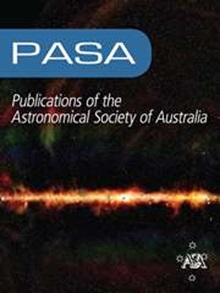利用监督机器学习对银河面上的紧凑射电源进行分类
IF 4.6
3区 物理与天体物理
Q1 ASTRONOMY & ASTROPHYSICS
Publications of the Astronomical Society of Australia
Pub Date : 2024-04-01
DOI:10.1017/pasa.2024.26
引用次数: 0
摘要
从处理过的数据产品中生成可用于科学研究的数据,是利用平方千米阵列(SKA)及其前身进行下一代射电连续面测量的主要挑战之一,这是因为预期的数据量和实现高度自动化处理的需要。源提取、表征和分类是这一过程的主要阶段。在这项工作中,我们的重点是利用射电和红外图像作为输入,对银河面上的紧凑射电源进行分类。为此,我们制作了一个包含 20,000 幅不同天文类别的紧凑射电源图像的数据集,这些图像来自过去的射电和红外巡天,以及澳大利亚 SKA 探路者(ASKAP)开展的试验性巡天获得的新射电数据。我们还获得了部分数据的射电光谱指数信息。然后,我们在生成的数据集上训练了两种不同的分类器。第一个模型使用梯度提升决策树,根据数据中预先计算出的一组特征进行训练,其中包括射电-红外色彩指数和射电光谱指数。第二个模型采用卷积神经网络,直接在多通道图像上进行训练。利用完全监督程序,我们获得了很高的分类准确率(F1-score>90%),可将银河系天体与河外背景区分开来。在加入远红外和光谱指数信息后,单个类别的识别率从 60% 到 75% 不等,提高了 10%,银河系外天体、PNe 和 HII 区域的识别准确率更高。实施的工具和训练的模型已公开发布,并提供给射电天文学界,供今后应用于新的射电数据。本文章由计算机程序翻译,如有差异,请以英文原文为准。
Classification of compact radio sources in the Galactic plane with supervised machine learning
Generation of science-ready data from processed data products is one of the major challenges in next-generation radio continuum surveys with the Square Kilometre Array (SKA) and its precursors, due to the expected data volume and the need to achieve a high degree of automated processing. Source extraction, characterization, and classification are the major stages involved in this process. In this work we focus on the classification of compact radio sources in the Galactic plane using both radio and infrared images as inputs. To this aim, we produced a curated dataset of ∼20,000 images of compact sources of different astronomical classes, obtained from past radio and infrared surveys, and novel radio data from pilot surveys carried out with the Australian SKA Pathfinder (ASKAP). Radio spectral index information was also obtained for a subset of the data. We then trained two different classifiers on the produced dataset. The first model uses gradient-boosted decision trees and is trained on a set of pre-computed features derived from the data, which include radio-infrared colour indices and the radio spectral index. The second model is trained directly on multi-channel images, employing convolutional neural networks. Using a completely supervised procedure, we obtained a high classification accuracy (F1-score>90%) for separating Galactic objects from the extragalactic background. Individual class discrimination performances, ranging from 60% to 75%, increased by 10% when adding far-infrared and spectral index information, with extragalactic objects, PNe and HII regions identified with higher accuracies. The implemented tools and trained models were publicly released, and made available to the radioastronomical community for future application on new radio data.
求助全文
通过发布文献求助,成功后即可免费获取论文全文。
去求助
来源期刊
CiteScore
5.90
自引率
9.50%
发文量
41
审稿时长
>12 weeks
期刊介绍:
Publications of the Astronomical Society of Australia (PASA) publishes new and significant research in astronomy and astrophysics. PASA covers a wide range of topics within astronomy, including multi-wavelength observations, theoretical modelling, computational astronomy and visualisation. PASA also maintains its heritage of publishing results on southern hemisphere astronomy and on astronomy with Australian facilities.
PASA publishes research papers, review papers and special series on topical issues, making use of expert international reviewers and an experienced Editorial Board. As an electronic-only journal, PASA publishes paper by paper, ensuring a rapid publication rate. There are no page charges. PASA''s Editorial Board approve a certain number of papers per year to be published Open Access without a publication fee.

 求助内容:
求助内容: 应助结果提醒方式:
应助结果提醒方式:


